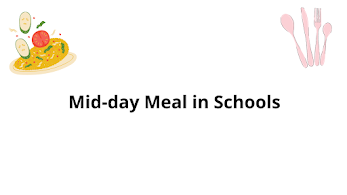Hints: Mid-day meal programme-12 crore primary school children under this scheme-the motto-impact on attendance-Govt. assistance provided-difficulties faced conclusion
Mid-day meal programme was introduced in India in 1925, for disadvantaged children in Madras Municipal Corporation. By 1990-91 about 17 states implemented this programme in primary schools. A recent statistics show that at present Mid-day meal is being provided to 12 crore primary school children. The noble motto fulfils the mission -“Eat together, learn together”. A hungry child does not like to attend school regularly. Chronic hunger leads to malnutrition that delays mental and physical growth of children.
Malnutrition causes diseases. Even if a child who is malnourished attends school, he finds it difficult to concentrate in the lessons in the class and so he will not be able to cope and hence drop out. The students who join school come from different communities and religions, so Mid-day meal develops a sense of fellow-feeling when they learn to sit together and share a common meal. Often girls are much more affected by hunger than boys and so it enhances attendance of girls in schools.
The government supplies free food grains and provides a subsidy for transportation of food grains. There are two other major inputs – they are cost of cooking which includes cooking ingredients like pulses, vegetables, rice, spices etc. and cost of fuel and remuneration to be paid for cooking, and provisions of infrastructure which includes kitchen-cum store, adequate supply of water for cooking, drinking and washing, cooking gas, containers to store foodgrains and other ingredients and utensils necessary for cooking and serving. For lack of adequate fund many State Governments have started distributing food grains among the students rather than cooking Mid-day meal.
There are many difficulties which this scheme has experienced. The existing cooking cost for a nutritious meal was inadequate. There are no kitchen-sheds or store-rooms, so classrooms are used for storage and cooking which is quite risky. Sometimes cooking is done in an open space which is unhealthy and full of hazards. The main objectives of this scheme are to improve the nutritional status of the children in classes I to V in government and government-aided schools and encourage poor children from disadvantaged sections, to attend regular classes and concentrate in studies and also provide nutritional support to primary school students in drought-affected areas during summer vacation.
This good scheme is facing the problems of superstition, casteism, lack of infrastructure, corruption. Some people feel that Mid-day meal scheme is giving more importance to eating than education. The government should do something different to implement this scheme and provide education to all.
